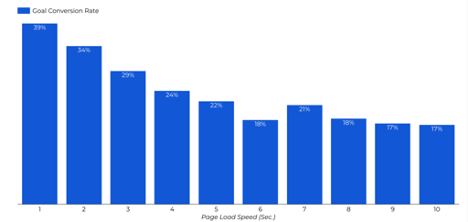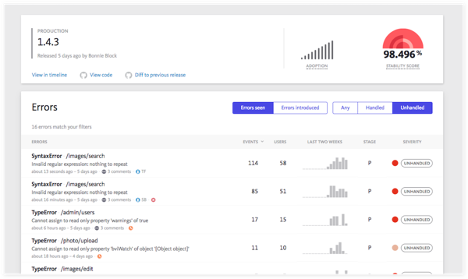How to Save Time & Accelerate Development with Error Tracking
Many software businesses focus on maximizing velocity and quickly getting new features to the market. But, the “move fast and break things” mentality can quickly lead to costly quality control issues. A better approach involves monitoring applications for error sin real-time to strike the right balance between quality and velocity
Let’s examine why error tracking matters and how Bugsnag can help you save time and accelerate development.
Real-time error monitoring solutions, like Bugsnag, can help you strike the right balance between quality and development velocity.
What is Error Tracking?
Error tracking involves proactively identifying and fixing an application’s issues as quickly as possible. While these processes may have been straightforward a decade ago, increasingly complex applications and infrastructures have complicated the process. As a result, many teams use dedicated error-tracking software to ensure complete coverage.

At the same time, the user experience has become essential for success as the software landscape becomes more competitive. Errors that negatively impact the user experience or cause unplanned downtime can lead to lost revenue and brand equity among customers. In fact, website conversion rates drop an average of 4.42% with each second of load time.
Error-tracking software can help mitigate these problems and ensure an optimal user experience. By monitoring server requests and responses, these applications can flag, document, and categorize errors, making it easy for development teams to assign and fix bugs quickly. That way, companies can confidently deploy changes and save time.
Error Tracking Strategies & Metrics
Most organizations appreciate the need for error tracking, but without a plan, these efforts aren’t as effective as they could be. For example, development teams may install error-tracking software and see a lot of errors. Without a way to prioritize them, teams may spend time fixing low-impact errors or experience notification fatigue and tune them out.
Successful error-tracking processes typically include:
- Detection – Error tracking software should record errors and make them accessible for development teams to fix. By grouping errors, you can also understand what underlying code may be most problematic. Ideally, these capabilities interface with development tools, making it easy to create and address new issues during a sprint.
- Prioritization – Development teams must prioritize errors based on their severity – not just the number of users impacted. For instance, an error processing payment may only affect a handful of users but could significantly impact revenue. Other errors, such as bots spamming applications with nonsense form data, may not matter.
- Intelligent Alerts – Alerts should route errors to the correct teams rather than broadcasting them to everyone. Every developer should have an “error inbox”with bugs worth fixing and actionable background information. That way, developers understand what they need to do without succumbing to the effects of notification fatigue.
In addition to creating these processes, organizations should develop key performance indicators (KPIs) to measure success and ensure quality. For example, they might track the error rate (e.g.,the rate of errors to requests) to assess the quality or the mean time to close errors (e.g., the time from error notification to fix) to evaluate efficiency.
But, at the same time, it’s a good idea to have a single north star metric. For example, you might use a stability score that reflects the number of unhandled errors versus total requests. You can use these metrics to determine when to focus on bugs versus new features and when anew or canary release is ready for deployment.
Best Practices with Bugsnag
Bugsnag is a robust platform that can help your organization track and fix errors quickly and efficiently. In particular, the platform can help you quickly set up error tracking and stability monitoring, automatically prioritize errors, efficiently route alerts to individual developers or teams, and trace errors through the application technology stack.

Identify & Prioritize Errors
Bugsnag makes it easy to pinpoint errors with the most significant impact using powerful search and segmentation. For example, you can bookmark different error segments, such as errors in a shopping cart or errors in the latest release. You can also segment errors by user spending, service level agreements, or subscription tiers to focus on what matters most.
Creating IntelligentAlerts
Bugsnag makes it easy to customize alerts based on specific segments and route them to specific teams or developers. You can easily drive code ownership and accelerate DevOps workflows around incident investigation and resolution through integrations with team chat, issue trackers, and incident management tools.
Effectively Group & Trace Errors
Bugsnag makes it easy to debut web, mobile, and server-side applications with a complete stack trace for every crash and breadcrumbs to help developers understand what happened. In addition, the platform automatically groups errors based on their root cause, making it easier to focus on the most problematic code.
Balance Bugs with Features
Bugsnag’s Stability Scores enable organizations to understand their application health at a glance. When a release experiences more unhandled errors than the target, the Stability Score falls into yellow or red territory, telling developers it’s time to take action. When the StabilityScore is green, the team can confidently focus on building new features.
In addition to these capabilities, Bugsnag integrates with all of the most common development tools, ranging from GitHub to GitLab to Jira. Enterprises can also opt to install an on-premise version of the software to maintain tight control over sensitive data while still reaping the benefits of real-time error tracking and remediation tools.
The Bottom Line
Error tracking is essential to ensure a robust user experience. Fortunately, Bugsnag makes it easy to monitor applications across the technology stack easy and intelligently route errors to developers. Just as important is the platform’s Stability Scores help organizations balance the need to build new features with the need to maintain quality. As a result, organizations can maximize their development velocity while ensuring an optimal user experience.
Start your free trial or request a demo today!